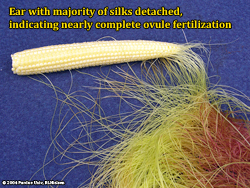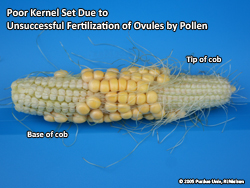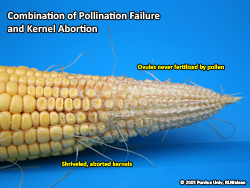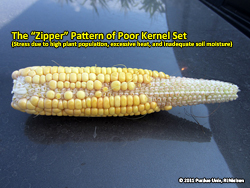27 July 2012
URL: http://www.kingcorn.org/news/articles.12/YldAssessment-0727.html
Opportunities to Assess Yield Potential of Drought-Stressed Corn
R.L. (Bob) Nielsen
Agronomy Dept., Purdue Univ.
West Lafayette, IN 47907-2054
Email address: rnielsen
at purdue.edu
![]() s the Great Drought of 2012 continues to wreak havoc with the corn crop throughout Indiana and elsewhere in the Midwest, there are several opportunities to assess the yield potential of individual damaged fields. In "normal" years, I would tell growers that the simple plant/ear/kernel count method for estimating grain yield prior to harvest (Nielsen, 2011b) is probably all they need to do to estimate the relative yield potential of their fields. However, the severity, duration, and variability of the stress of the current drought ranks among the worst in recent Indiana history. Combined with the additional stress imposed by days of excessively high temperatures, the consequences are already severe in many fields and will yet become so in more fields in the coming weeks.............. All at a point in the growing season that is way earlier than the traditional kernel count method was designed for.
s the Great Drought of 2012 continues to wreak havoc with the corn crop throughout Indiana and elsewhere in the Midwest, there are several opportunities to assess the yield potential of individual damaged fields. In "normal" years, I would tell growers that the simple plant/ear/kernel count method for estimating grain yield prior to harvest (Nielsen, 2011b) is probably all they need to do to estimate the relative yield potential of their fields. However, the severity, duration, and variability of the stress of the current drought ranks among the worst in recent Indiana history. Combined with the additional stress imposed by days of excessively high temperatures, the consequences are already severe in many fields and will yet become so in more fields in the coming weeks.............. All at a point in the growing season that is way earlier than the traditional kernel count method was designed for.
Clearly, the yield potential of fields whose plants are already dead is pretty easy to determine. The more uncertain situations are those fields that appear to be less than disastrous based on windshield surveys.
1st Opportunity: In another article (Nielsen, 2012), I described the "ear shake" technique that can be used to assess the success or failure of pollination. Normally, this technique falls into the category of "casual interest" because the pollination process is usually not a problematic issue. However, this year the combination of severe drought and excessive heat during pollination has seriously compromised that process in quite a few fields. The "ear shake" technique can be used as early as 5 to 6 days after silks are pollinated by pollen and, thus, represents an early assessment of relative yield potential; i.e., good, bad, or in between. Most of Indiana's corn crop is beyond this point, but there are a few fields just now attempting to pollinate or have recently pollinated, so there may be a few opportunities to use this method yet this season.
2nd Opportunity: Even if pollination occurred successfully, subsequent severe drought and excessive heat can cause significant kernel abortion throughout the developing ear during the blister and milk stages of kernel development (Nielsen, 2008). The younger kernels on an ear are most susceptible to photosynthetic stress and thus are at most risk of kernel abortion.
Much of the state's corn crop is still in this vulnerable stage of kernel development with only 22% of the crop statewide estimated to have reached the dough stage of kernel development as of 22 July (USDA-NASS, 2012). This fact is also why rainfall now may indeed have dramatic benefits to the corn crop if it prevents significant rates of kernel abortion.
With "normal" stress following pollination, kernel abortion typically occurs near the tip of the developing ear because those kernels are usually younger. Silks from those ovules usually emerge later than those from the ovules lower on the cob and, thus, are last to be fertilized by pollen. When severe stress exists prior to and during pollination, silk emergence may be somewhat more random or pollen fertilization more erratic. Consequently, kernel "age" may be more random throughout the ear and kernel abortion thus also more random in its pattern (Nielsen, 2011c; Nielsen, 2011d). Assessing the degree of kernel abortion shortly after the milk stage of development can help you assess relative yield potential; i.e., good, bad, or in between.
3rd Opportunity: The last opportunity to assess yield potential prior to harvest is near physiological maturity (kernel black layer, Nielsen, 2008) using the so-called yield component method (Nielsen, 2011b). Technically, you can use this method at the dough or dent stages of kernel development, but waiting until physiological maturity allows you to assess kernel depth (aka size or weight). This allows you to "fine-tune" the yield estimate by tweaking the kernel weight "fudge factor" in the formula. Even so, this yield estimation method probably is no more accurate than about 20-30 bu/ac.
Recognize that estimates of grain yield under drought conditions are difficult at best because of the challenge of assessing the spatial variability for drought stress within fields. It is not easy or enjoyable to thoroughly walk a large field to collect reliable ear samples. However, any opportunity to assess yield potential of stressed fields will help identify the severity of the yield losses and may help you modify your grain marketing decisions this fall.
Related reading
Nafziger, Emerson. 2012. Estimating Yields of Stressed Corn. The Bulletin, Univ of Illinois. http://bulletin.ipm.illinois.edu/article.php?id=1695 [URL checked July 2012].
Nielsen, RL (Bob). 2008. Grain Fill Stages in Corn. Corny News Network, Purdue University. http://www.agry.purdue.edu/ext/corn/news/timeless/grainfill.html. (URL checked July 2012).
Nielsen, RL (Bob). 2011a. Effects of Stress During Grain Filling in Corn. Corny News Network, Purdue Extension. http://www.kingcorn.org/news/timeless/GrainFillStress.html [URL checked July 2012].
Nielsen, RL (Bob). 2011b. Estimating Corn Grain Yield Prior to Harvest. Corny News Network, Purdue University. http://www.agry.purdue.edu/ext/corn/news/timeless/YldEstMethod.html. (URL checked July 2012).
Nielsen, RL (Bob). 2011c. Kernel Set Scuttlebutt. Corny News Network, Purdue Extension. http://www.kingcorn.org/news/timeless/KernelSet.html [URL checked July 2012].
Nielsen, RL (Bob). 2011d. The "Zipper" Pattern of Poor Kernel Set in Corn. Corny News Network, Purdue Extension. http://www.kingcorn.org/news/timeless/Zipper.html [URL checked July 2012].
Nielsen, RL (Bob). 2012. A Fast & Accurate Pregnancy Test for Corn. Corny News Network, Purdue University. http://www.agry.purdue.edu/ext/corn/news/timeless/EarShake.html. (URL checked July 2012).





